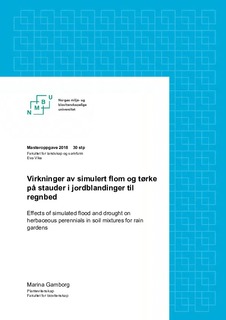| dc.contributor.advisor | Eva, Vike | |
| dc.contributor.advisor | Børresen, Trond | |
| dc.contributor.advisor | Haraldsen, Trond Knapp | |
| dc.contributor.author | Gamborg, Marina | |
| dc.date.accessioned | 2018-11-20T10:25:32Z | |
| dc.date.available | 2018-11-20T10:25:32Z | |
| dc.date.issued | 2018 | |
| dc.identifier.uri | http://hdl.handle.net/11250/2573940 | |
| dc.description.abstract | Denne masteroppgaven inngår i et oppdrag fra Statens vegvesen i forbindelse med et veiprosjekt i Drammen med et omfattende regnbedsystem. Statens vegvesen ønsket å teste flere jordblandinger som kunne egne seg til bruk i et regnbed. Det ble komponert 6 ulike jordblandinger med materialer fra Skaaret Landskap AS og 6 jordblandinger med materialer fra Lindum AS. Jordblandingene var komponert med økende innhold av finstoff og med ulike typer kompost samt en type torv.
For å kunne teste de ulike jordblandingene ble det i slutten av juni etablert et utendørs potteforsøk under transparent tak, der det ble dyrket fire staudeslag. Følgende stauder var brukt i forsøket: Amsonia orientalis Decne., Eurybia divaricata (L.) G. L. Nesom, Hemerocallis ‘Golden Chimes’ og Luzula sylvatica (Huds.) Gaudin. Den første måneden vokste staudene under normalt vanningsregime. Deretter ble plantene utsatt for vekselvis simulering av flom og tørke. | nb_NO |
| dc.description.abstract | This master thesis is part of an assignment from The Norwegian Public Roads Administration on the occasion of a road construction project in Drammen including a comprehensive rain garden system. The Norwegian Public Roads Administration wanted to test several soil mixtures that could be suitable for use in a rain garden. Six soil mixtures were composed using materials from Skaaret Landskap AS and six soil mixtures with materials from Lindum AS. The soil mixtures were composed with increasing content of fine particles and with dissimilar types of compost in addition to one type of peat.
In order to test the different soil mixtures an outdoor pot experiment, growing three herbaceous perennial species and one cultivar, was established under a transparent roof in the end of June. The following herbaceous perennials were used in the experiment: Amsonia orientalis Decne., Eurybia divaricata (L.) G. L. Nesom, Hemerocallis ‘Golden Chimes’, and Luzula sylvatica (Huds.) Gaudin. During the first month crops were grown under a normal water regime; thereafter they were exposed to alternate simulations of flooding and drought. | nb_NO |
| dc.description.sponsorship | Statens vegvesen | nb_NO |
| dc.language.iso | nob | nb_NO |
| dc.publisher | Norwegian University of Life Sciences, Ås | nb_NO |
| dc.rights | Attribution-NonCommercial-NoDerivatives 4.0 Internasjonal | * |
| dc.rights.uri | http://creativecommons.org/licenses/by-nc-nd/4.0/deed.no | * |
| dc.subject | Regnbed | nb_NO |
| dc.subject | Luzula sylvatica | nb_NO |
| dc.subject | Amsonia orientalis | nb_NO |
| dc.subject | Eurybia divaricata | nb_NO |
| dc.subject | Hemerocallis 'Golden Chimes' | nb_NO |
| dc.subject | Flomsimulering | nb_NO |
| dc.title | Virkninger av simulert flom og tørke på stauder i jordblandinger til regnbed | nb_NO |
| dc.title.alternative | Effects of simulated flood and drought on herbaceous perennials in soil mixtures for rain gardens | nb_NO |
| dc.type | Master thesis | nb_NO |
| dc.description.localcode | M-PV | nb_NO |

